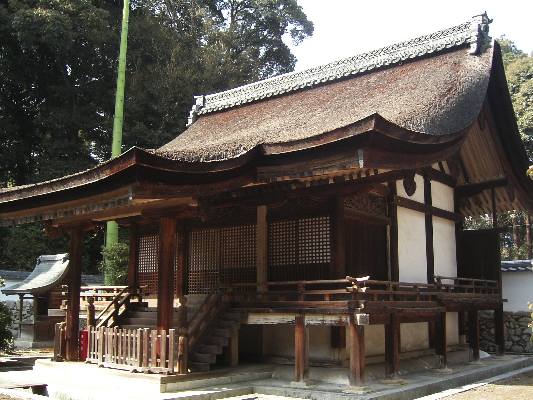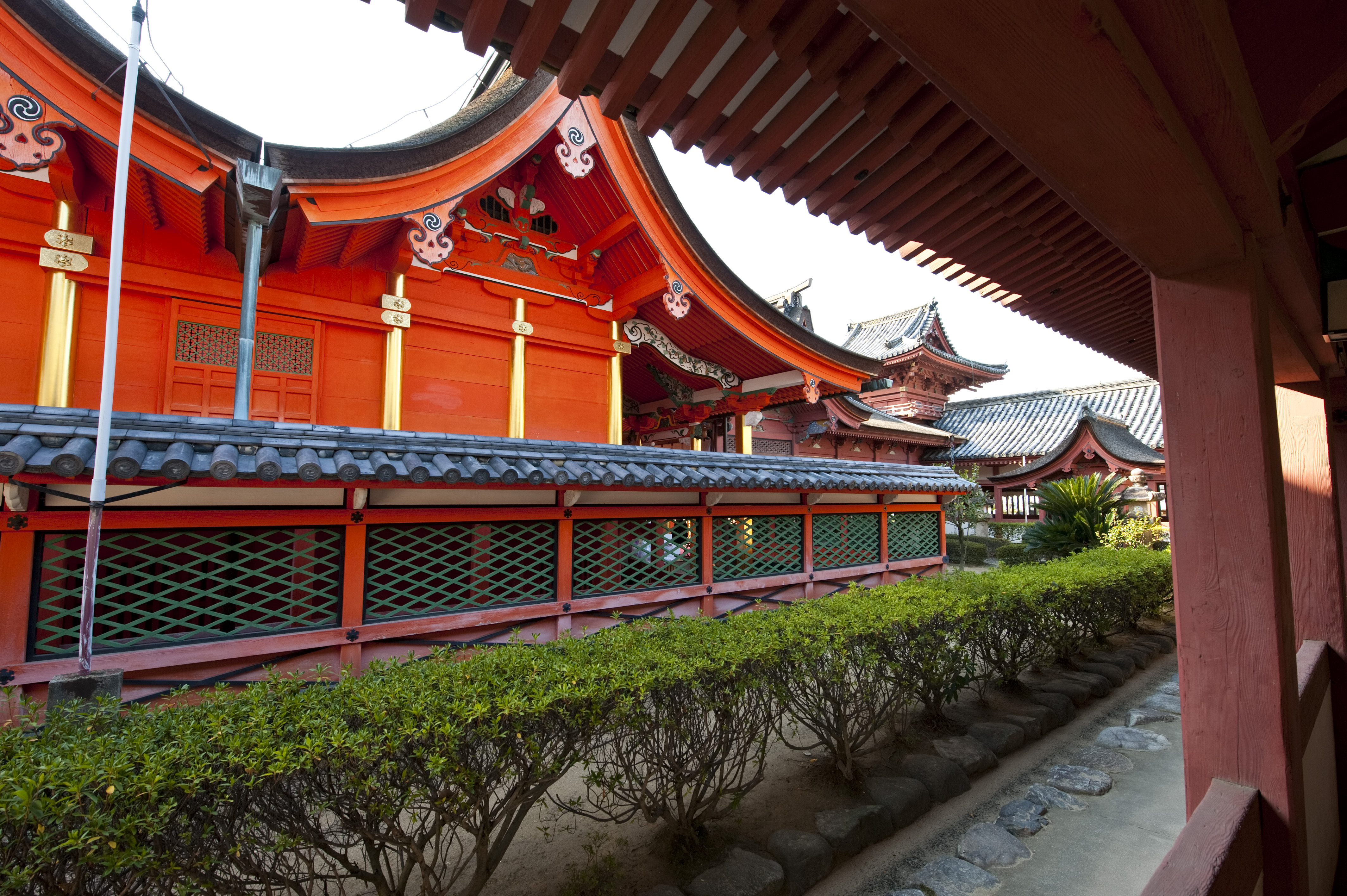|
Hachiman-zukuri
The is a traditional Japanese architectural style used at Hachiman shrines in which two parallel structures with gabled roofs are interconnected on the non-gabled side, forming one building which, when seen from the side, gives the impression of two.JAANUSHachiman-zukuriaccessed on December 1, 2009 The front structure is called , the rear one , and together they form the ''honden''.History and Typology of Shrine Architecture Encyclopedia of Shinto accessed on November 2009 The ''honden'' itself is surrounded by a -like covered corridor called (see photo). Access is made possible by a gate called . It has a structure, that is, the building has its main entrance on the ... [...More Info...] [...Related Items...] OR: [Wikipedia] [Google] [Baidu] |
Glossary Of Shinto
This is the glossary of Shinto, including major terms on the subject. Words followed by an asterisk (*) are illustrated by an image in one of the photo galleries. __NOTOC__ A * – A red papier-mâché cow bobblehead toy; a kind of ''engimono'' and an ''omiyage'' (a regional souvenir in Japan) that is considered symbolic of Aizu. * – A type of fan held by aristocratic women of the Heian period when formally dressed; it is brightly painted with tassels and streamers on the ends. Held today in Shinto by a ''miko'' in formal costume for festivals. See also ''hiôgi''. * – The term's meaning is not limited to moral evil, and includes misfortune, inferiority and unhappiness. * - A malevolent fire spirit, demon or devil. * - Also known as the ''Akujin'', the ''Kibi-no-Ananowatari-no-Kami'' and as the ''Anato-no-Kami'', ''Akuru'' is a malevolent ''kami'' that is mentioned in the ''Keikoki'' (records regarding the time of the Emperor Keiko), the ''Nihonshoki'' (Chronicles of ... [...More Info...] [...Related Items...] OR: [Wikipedia] [Google] [Baidu] |
Hirairi
is a Japanese traditional architectural structure, where the building has its main entrance on the side which runs parallel to the roof's ridge (non gabled-side). The ''shinmei-zukuri'', ''nagare-zukuri'', ''hachiman-zukuri'', and '' hie-zukuri'' Shinto architectural styles belong to this type. It survives mostly in religious settings. In residential buildings, the entrance side is usually the long one, but from the Edo period The or is the period between 1603 and 1867 in the history of Japan, when Japan was under the rule of the Tokugawa shogunate and the country's 300 regional '' daimyo''. Emerging from the chaos of the Sengoku period, the Edo period was character ... onward the opposite became more frequent. References {{Authority control Shinto shrines Architecture in Japan ... [...More Info...] [...Related Items...] OR: [Wikipedia] [Google] [Baidu] |
Edo Period
The or is the period between 1603 and 1867 in the history of Japan, when Japan was under the rule of the Tokugawa shogunate and the country's 300 regional '' daimyo''. Emerging from the chaos of the Sengoku period, the Edo period was characterized by economic growth, strict social order, isolationist foreign policies, a stable population, perpetual peace, and popular enjoyment of arts and culture. The period derives its name from Edo (now Tokyo), where on March 24, 1603, the shogunate was officially established by Tokugawa Ieyasu. The period came to an end with the Meiji Restoration and the Boshin War, which restored imperial rule to Japan. Consolidation of the shogunate The Edo period or Tokugawa period is the period between 1603 and 1867 in the history of Japan, when Japan was under the rule of the Tokugawa shogunate and the country's regional '' daimyo''. A revolution took place from the time of the Kamakura shogunate, which existed with the Tennō's court, to ... [...More Info...] [...Related Items...] OR: [Wikipedia] [Google] [Baidu] |
Haiden (Shinto)
In Shinto shrine architecture, the is the hall of worship or oratory. It is generally placed in front of the shrine's main sanctuary (''honden'') and often built on a larger scale than the latter. The ''haiden'' is often connected to the ''honden'' by a '' heiden'', or hall of offerings. While the ''honden'' is the place for the enshrined ''kami'' and off-limits to the general public, the ''haiden'' provides a space for ceremonies and for worshiping the ''kami''. In some cases, for example at Nara's Ōmiwa Shrine , also known as , is a Shinto shrine located in Sakurai, Nara Prefecture, Japan. The shrine is noted because it contains no sacred images or objects because it is believed to serve Mount Miwa, the mountain on which it stands. For the same re ..., the ''honden'' can be missing and be replaced by a patch of sacred ground. In that case, the ''haiden'' is the most important building of the complex. References Shinto architecture {{Shinto-stub ja:拝殿 [...More Info...] [...Related Items...] OR: [Wikipedia] [Google] [Baidu] |
Matsuyama, Ehime
270px, Matsuyama City Hall 270px, Ehime Prefectural Capital Building is the capital city of Ehime Prefecture on the island of Shikoku in Japan and also Shikoku's largest city. , the city had an estimated population of 505,948 in 243541 households and a population density of 1200 persons per km². The total area of the city is . Geography Matsuyama is located in central Ehime Prefecture, facing the Seto Inland Sea to the north, the mountains of the Takanawa Peninsula to the north and east, and the Saragamine Mountain Range, an extension of the Shikoku Mountains, to the south. It is located on the northeastern portion of the Dōgo Plain. The city also includes the Kutsuna Islands, an archipelago of 29 islands in the Seto Inland Sea. Neighbouring municipalities Ehime Prefecture * Tōon * Imabari * Tobe * Masaki * Kumakōgen Climate Matsuyama has a humid subtropical climate (Köppen climate classification ''Cfa''; Trewartha climate classification ''Cf'') with hot summers ... [...More Info...] [...Related Items...] OR: [Wikipedia] [Google] [Baidu] |
Isaniwa Shrine
is a Shinto shrine in Matsuyama, Ehime Prefecture, Japan. Enshrined are Emperor Chūai, Empress Jingū, and Emperor Ōjin. A number of its buildings and treasures have been designated Important Cultural Properties. History It is said that the shrine was founded on the site where Emperor Chūai and Empress Jingū bathed at Dōgo Onsen and it is mentioned in Engi shiki. In the fourteenth century the Kōno clan moved the shrine to its present location and it was rebuilt by the Matsudaira clan in the seventeenth century. Isaniwa Jinja was restored in 1970. Buildings Isaniwa Jinja is modelled upon Iwashimizu Hachiman-gū in Kyoto Prefecture and constructed in the Hachiman-zukuri style. * Honden (1667) ( Important Cultural Property) * Mōshidono corridor (1667) (ICP) * Rōmon (1667) (ICP) * Kairō (1667) (ICP) * Massha (ICP) Treasures A treasure hall houses a number of swords and suits of armour. * Tachi (Kamakura period The is a period of Japanese history that marks the gov ... [...More Info...] [...Related Items...] OR: [Wikipedia] [Google] [Baidu] |
Shinden-zukuri
''Shinden-zukuri'' (寝殿造) refers to an architectural style created in the Heian period (794-1185) in Japan and used mainly for palaces and residences of nobles. In 894, Japan abolished the ''kentōshi'' (Japanese missions to Tang China), distanced itself from Chinese culture, and brought into bloom a culture called Kokufu bunka'' (lit., national culture), which was in keeping with the Japanese climate and aesthetic sense. This style was an expression of ''Kokufu bunka'' in architecture, clearly showing the uniqueness of Japanese architecture and defining the characteristics of later Japanese architecture. Its features include an open structure with few walls that can be opened and closed with doors, '' shitomi'' and ''sudare'', a structure in which people take off their shoes and enter the house on stilts, sitting or sleeping directly on '' tatami'' mats without using chairs or beds, a roof made of laminated ''hinoki'' (Japanese cypress) bark instead of ceramic tiles, a ... [...More Info...] [...Related Items...] OR: [Wikipedia] [Google] [Baidu] |
Heian Period
The is the last division of classical Japanese history, running from 794 to 1185. It followed the Nara period, beginning when the 50th emperor, Emperor Kanmu, moved the capital of Japan to Heian-kyō (modern Kyoto). means "peace" in Japanese. It is a period in Japanese history when the Chinese influences were in decline and the national culture matured. The Heian period is also considered the peak of the Japanese imperial court and noted for its art, especially poetry and literature. Two types of Japanese script emerged, including katakana, a phonetic script which was abbreviated into hiragana, a cursive alphabet with a unique writing method distinctive to Japan. This gave rise to Japan's famous vernacular literature, with many of its texts written by court women who were not as educated in Chinese compared to their male counterparts. Although the Imperial House of Japan had power on the surface, the real power was in the hands of the Fujiwara clan, a powerful aris ... [...More Info...] [...Related Items...] OR: [Wikipedia] [Google] [Baidu] |
Lotus Sūtra
The ''Lotus Sūtra'' ( zh, 妙法蓮華經; sa, सद्धर्मपुण्डरीकसूत्रम्, translit=Saddharma Puṇḍarīka Sūtram, lit=Sūtra on the White Lotus of the True Dharma, italic=) is one of the most influential and venerated Buddhist Mahāyāna sūtras. It is the main scripture on which the Tiantai, Tendai, Cheontae, and Nichiren schools of Buddhism were established. It is also influential for other East Asian Buddhist schools, such as Zen. According to the British Buddhologist Paul Williams, "For many Buddhists in East Asia since early times, the ''Lotus Sūtra'' contains the final teaching of Shakyamuni Buddha—complete and sufficient for salvation." The American Buddhologist Donald S. Lopez Jr. writes that the ''Lotus Sūtra'' "is arguably the most famous of all Buddhist texts," presenting "a radical re-vision of both the Buddhist path and of the person of the Buddha." Two central teachings of the ''Lotus Sūtra'' have been very inf ... [...More Info...] [...Related Items...] OR: [Wikipedia] [Google] [Baidu] |
Tōdai-ji
is a Buddhist temple complex that was once one of the powerful Seven Great Temples, located in the city of Nara, Japan. Though it was originally founded in the year 738 CE, Tōdai-ji was not opened until the year 752 CE. The temple has undergone several reconstructions since then, with the most significant reconstruction (that of the Great Buddha Hall) taking place in 1709. Its Great Buddha Hall (大仏殿 ''Daibutsuden'') houses the world's largest bronze statue of the Buddha Vairocana, known in Japanese as ''Daibutsu'' (大仏). The temple also serves as the Japanese headquarters of the Kegon school of Buddhism. The temple is a listed UNESCO World Heritage Site as one of the "Historic Monuments of Ancient Nara", together with seven other sites including temples, shrines and places in the city of Nara. History Origins The beginning of building a temple where the Kinshōsen-Ji complex sits today can be dated to 728 CE, when Emperor Shōmu established Kinshōsen-Ji (金� ... [...More Info...] [...Related Items...] OR: [Wikipedia] [Google] [Baidu] |








